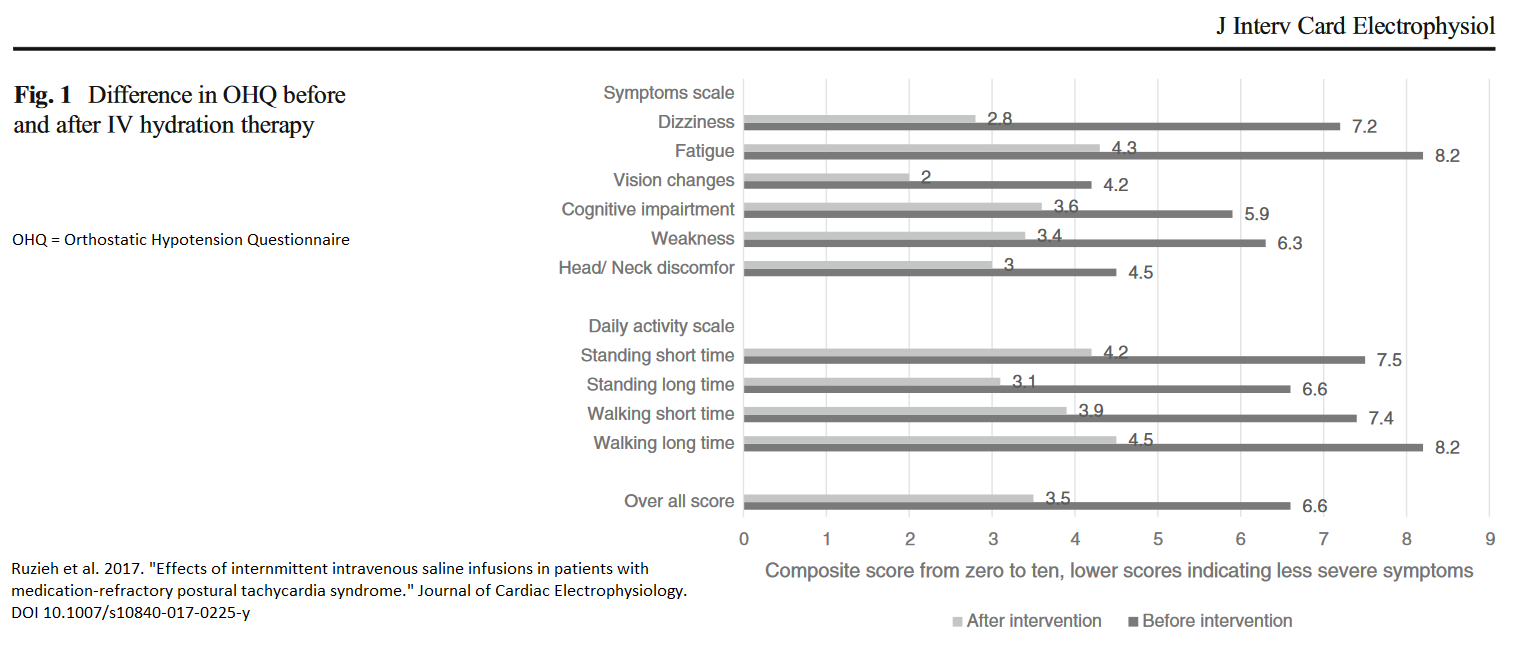There is considerable contention among physicians about the efficacy of using intravenous hydration in POTS patients. Some are concerned about increasing blood pressure as they increase blood volume, particularly in patients with hyperadrenergic POTS. Others are concerned that use of IV fluids long-term may be counterproductive as the body may decrease fluid absorption or retention as it adjusts to these infusions. In other cases, like the small study below, physicians are finding that intermittent intravenous fluids may help to decrease symptoms and improve quality of life.
If you are considering using IV fluids for POTS patients, here is a protocol that showed positive results (Ruzieh et al., 2017):
- Initial treatments: 1 liter of IV normal saline infused over 1-2 hours weekly
- Titrated dose depending on patient needs
- Up: 2 liters of IV normal saline per week
- Down: 1 liter of IV normal saline every 2-4 weeks
This study demonstrated significant improvements in patient functionality with intermittent intravenous fluids. IV fluids significantly decreased symptoms in 93% of POTS patients (in a study of 53 POTS patients), leading to significant improvement in quality of life (Ruzieh et al. 2017). Most patients reported immediate improvement that lasted several days. Intravenous hydration may be an ideal bridge therapy to allow the implementation of longer-term interventions in highly symptomatic patients. In this study, 44% weaned themselves from IV fluids in three months or less, and 94% had weaned themselves within six months. Four participants relapsed, and required IV hydration again but their average frequency of infusion was lower during treatment of the flare (Ruzieh et al. 2017). For additional studies on IV fluids in POTS, please click here.

Please note that an article published in 2018 indicates that administration of balanced crystalloids for routine intravenous fluid therapy in noncritically ill adults resulted in lower incidence of major adverse kidney events than normal saline (Self et al., 2018). In the US, normal saline is the most commonly used isotonic crystalloid fluid (0.9% sodium chloride), and has a chloride concentration higher than human plasma. Physiologically balanced crystalloids like Ringer's solution and Plasma-Lyte A are more similar to human plasma (Self et al., 2018). It is not known how these balanced cystalloids would affect POTS patients as part of their intermittent fluid therapy.
Literature Cited
Ruzieh et al. 2017. "Effects of intermittent intravenous saline infusions in patients with medication-refractory postural tachycardia syndrome." Journal of Cardiac Electrophysiology. DOI 10.1007/s10840-017-0225-y
Self, et al. 2018. "Balanced crystalloids versus saline in noncritically ill adults." New England Journal of Medicine 378:819-828.